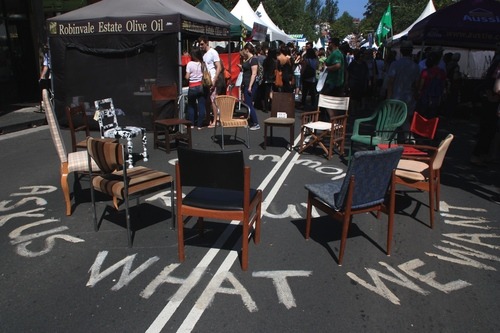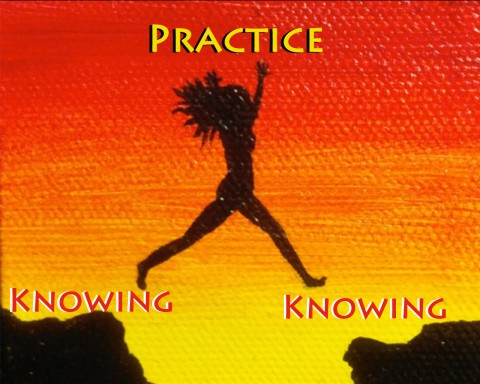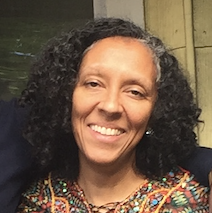Posted in Featured
May 14, 2014

In a number of the social change networks that I am supporting there is very active and interesting conversation, and experimentation, going on around what I would call the process-action tension. As I have written elsewhere, I see this as a bit of a false and often unhelpful dichotomy, and I have certainly seen and been part of networks that have gotten bogged down in some version of analysis paralysis and never-ending consensus building. Increasingly there is a leaning towards getting out there sooner than later and trying things, learning from experiments and actions, readjusting, etc., which is all well and good. At the same time, I see it as part of my role to raise questions about how the embrace of “do-acracy” might have unintended consequences around long-term alignment as well as sustained and truly systemic impact. Read More
May 12, 2014
Mellody Hobson, President of Ariel Investments and chair of the board for DreamWorks Animation challenges us to be “color brave” instead of “color blind.” Here are a few snippets from her TED talk. Well worth listening to in its entirety.
“[R]esearchers have coined this term “color blindness” to describe a learned behavior where we pretend that we don’t notice race. If you happen to be surrounded by a bunch of people who look like you, that’s purely accidental. Now, color blindness, in my view, doesn’t mean that there’s no racial discrimination, and there’s fairness. It doesn’t mean that at all. It doesn’t ensure it. In my view, color blindness is very dangerous because it means we’re ignoring the problem… this subject matter can be hard, awkward, uncomfortable — but that’s kind of the point… If we can learn to deal with our discomfort, and just relax into it, we’ll have a better life.
“So I think it’s time for us to be comfortable with the uncomfortable conversation about race: black, white, Asian, Hispanic, male, female, all of us, if we truly believe in equal rights and equal opportunity in America, I think we have to have real conversations about this issue. We cannot afford to be color blind. We have to be color brave. We have to be willing, as teachers and parents and entrepreneurs and scientists, we have to be willing to have proactive conversations about race with honesty and understanding and courage, not because it’s the right thing to do, but because it’s the smart thing to do, because our businesses and our products and our science, our research, all of that will be better with greater diversity…
“I’m actually asking you to do something really simple: observe your environment, at work, at school, at home. I’m asking you to look at the people around you purposefully and intentionally. Invite people into your life who don’t look like you, don’t think like you, don’t act like you, don’t come from where you come from, and you might find that they will challenge your assumptions and make you grow as a person…
“I’m asking you to show courage. I’m asking you to be bold. As business leaders, I’m asking you not to leave anything on the table. As citizens, I’m asking you not to leave any child behind. I’m asking you not to be color blind, but to be color brave, so that every child knows that their future matters and their dreams are possible.”
May 6, 2014
It’s good to plan. It’s good to reflect. It’s best to do.
Here at IISC we spend a fair amount of time supporting others in articulating what they want to achieve, including those who must be included, and defining a pathway to action. When done well, this work depends on a fair amount of reflection on practice – how do you think about what you do? What are you learning about what you do?
We also train people. We help them become better facilitative leaders. We introduce specific practices – specific things people can do.
Without the practice the lessons are lost. We learn by doing.
I was just talking about this in our office kitchen with Danielle Coates-Connor, one of our colleagues, and she compared it to meditation.
It is quite hip to talk about meditation these days. Mindfulness is in. At least in theory. People have a sense that stillness of the mind and present moment awareness are powerful ways to live and thrive. But there is a huge gap between knowing this and practicing this. Too many of us still believe that thinking about meditation is a lot like meditation. But it’s not.

The same is true for our projects and our dreams. We can get the right stakeholders together. We can talk about what we want to do. We can visualize it. We can plot it out. But the learning doesn’t begin until we start. The change does not begin until we do.
Do you wonder:
How to integrate more “doing” in your “planning?”
How to integrate more “doing” in your “reflecting?”
How to start experimenting as soon as possible?
How to start learning?
March 26, 2014

Over the last few weeks I have fielded a number of calls from people who are interested in figuring out how to develop different kinds of networks. I’m always eager to have these conversations, precisely because there is no single right answer, and it really comes down to a process of discovery and experimentation based on the unique nature of the network and system in question. That said, I do like to ask people the question, “What are you doing to feed your network?” Read More
March 14, 2014

Last week Darren Walker opened the Resilient Cities lunch reminding us that not only do we need to work to make cities resilient and sustainable, we must also work to make them just. As I listened to Xav Briggs, Joan Clos, Toni Griffin and others speak, I thought about my work at MIT’s Department of Urban Studies and Planning and what working to make just cities means for planning and planners. How does one attend to the myriad issues facing cities: poverty, crumbling infrastructure, environmental sustainability and economic collapse? Read More
March 4, 2014

I’m just getting back from a four-week sabbatical, a special gift from IISC after seven years of service. I grew in leaps and bounds. A lot of what been brewing inside of me for the last year or two started to come together in a powerful way. My time off was anchored by a week-long, life changing, couples’ retreat in Mexico.
Read More
March 3, 2014

Four compelling questions came to me via the monthly newsletter of Conditioning Leaders, led by our colleague Madeline McNeely. She’s reflecting on 20 years of work and asking herself some great questions that we should all be asking ourselves as our year gets into full swing:
Read More
February 27, 2014
In “networks-as-change,” effectiveness is grounded in affectiveness.

In an essay that I continue to revisit, the poet/essayist/novelist/farmer/ conservationist and champion of overall sanity, Wendell Berry, talks about what he calls “the turn towards affection.” Having spent many years reflecting on and pushing back against the unfortunate demonstrated human tendency to despoil landscapes and “the other,” he takes a strong stand for both deep rooted connection and . . . imagination: Read More
February 24, 2014

Enjoy these simple and powerful guidelines from Beth Kanter about how movement makes meetings and workshops more productive. This is great advice for getting beyond designing for “brains on sticks” as my colleague Curtis Ogden likes to say.
As a trainer and facilitator who works with nonprofit organizations and staffers, you have to be obsessed with learning theory to design and deliver effective instruction, have productive meetings, or embark on your own self-directed learning path. Learning theory is an attempt to describe how people learn. There are many learning theories and can be categorized in different ways:
Read More
February 6, 2014
Collaboration is “a mutually beneficial relationship between two or more parties to achieve common goals by sharing responsibility, authority and accountability for achieving results. It is more than simply sharing knowledge and information (communication) and more than a relationship that helps each party achieve its own goals (cooperation and coordination). The purpose of collaboration is to create a shared vision and joint strategies to address concerns that go beyond the purview of any particular party.”
-David Chrislip and Chip Larson, 1994, p. 5

For a while now at IISC, we’ve referred to the above definition from Chrislip and Larson’s work, Collaborative Leadership, to describe the goal of our collaborative capacity building work. And it has informed our approach around supporting social change networks. Read More
January 24, 2014

When we at IISC look at problem or an opportunity, we look at it through the lens of love. This doesn’t mean we approach the world with rose-colored glasses: it means that we focus on the transcendent possibilities that are apparent when we hold every person in unconditional high regard.
Read More
January 22, 2014
“Love is essential, gregariousness is optional.”
-Susan Cain
 “How Not to Manage an Introvert” (by Nguyen Hung Vu)
“How Not to Manage an Introvert” (by Nguyen Hung Vu)
For several months I’ve been meaning to read Susan Cain’s book Quiet: The Power of Introverts in a World That Won’t Stop Talking. Having completed it this past weekend, I have both a sense of validation (being one of ever-more introverted tendencies as the years pass) and being able to see with new eyes. IMHO, it is well worth the read, and if the thought of tackling the 300 pages is daunting, you might enjoy a taste via Cain’s TED Talk.
Here I wanted to reflect on some of the insights Cain’s work has to offer collaboration and “net work” for change. Read More












